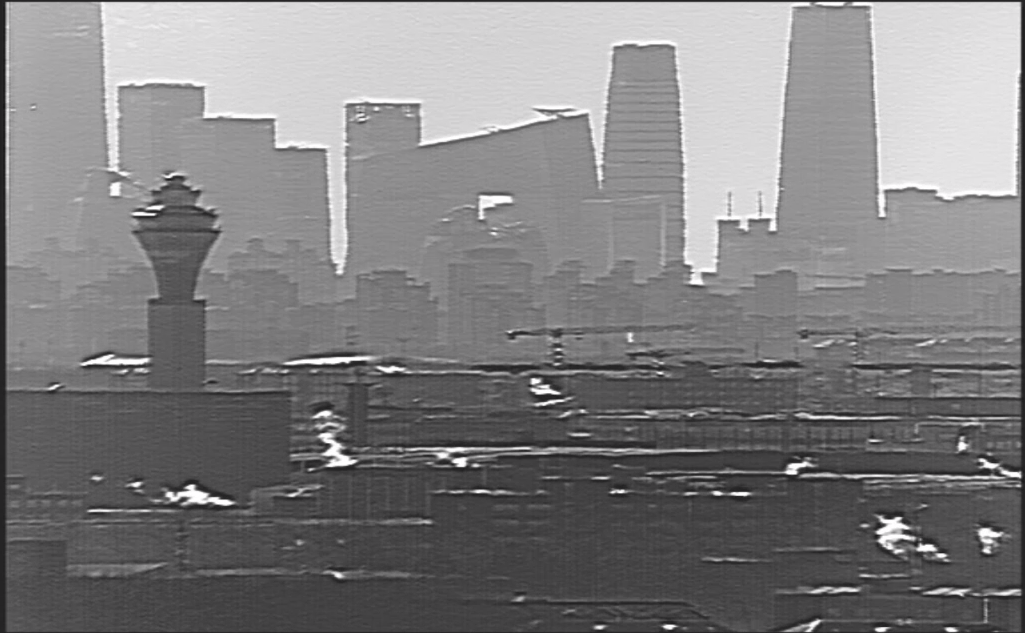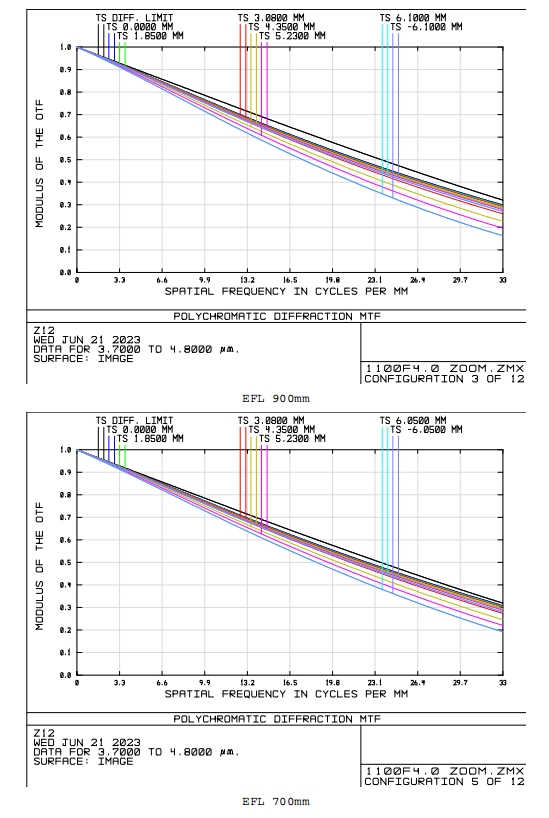Optical Parameters:
| Focal Length | 90mm to 1100mm | Operating Temperature Range | -40℃ to +60℃ |
| F/# | 5.5 | Working Wavelength Range | 3.7μm to 4.8μm |
| Coating on Front Surface Exposing to Air | AR/DLC, Optional |
Mechanical Specifications:
| Focusing Mechanism | Motorized | Weight | 4.2kg |
| Lens Housing Material | Black Anodized Aluminum | Max.Dimensions (DiameterxLength) | ɸ223x295.51mm |
| Connector | Refer to Drawing |
Electronics:
| Zoom, Focus Mechanism | DC gear motor control | Zoom, Focus Position Feedback | Encoder |
| Zoom, Focus Driving Voltage | 12V DC |
FOV-Sensor Size:
| FOV | 640x512-15μm |
|
| H | 6.11° to 0.5° | |
| V | 4.89° to 0.4° |
It is common that thermal cameras oriented for long-range detection often suffer from overweight problems. This is because, in imaging instruments, a substantial volume of electromagnetic radiation must be allowed to reach the sensor. longer focal lengths therefore must be compensated through larger lens apertures to ensure sufficient radiation exposure, thus long-range thermal camera lenses are often made into large diameters, leading to massive weights and enormous dimensions. In general, weighs between 5-8kg. In application contexts like drones and defense surveillance, a little increment of weight and size could have great adverse impacts, for example, increasing power consumption, reducing the moving velocities, etc.
Besides the weight issue, with the increasing technological demand for capturing clear images at extreme distances and harsh visual conditions, the market also poses challenges for the suppliers of long-range infrared lenses. The prior purpose of long-range infrared lenses is to extend the detection distance, providing a clear and detailed view of objects or scenes from afar, therefore achieving remarkable detection distances is paramount for applications like surveillance, reconnaissance, and monitoring. Other requirements for long-range infrared lenses include a flexible zooming mechanism, diffraction-limited MTF, reliable optical performance, etc.
Shalom EO's 90mm to 1100mm f/5.5 Continuous Zoom MWIR Thermal Camera Lenses For Cooled Detectors features:
1. Staggering Detection Range up to 35km:
The long-range infrared lenses cover a staggering detection range of up to 35km, being capable of monitoring vast landscapes, and providing detection over a wide area. The lenses are excellent when assigned to various missions requiring long detection ranges and high thermal contrast, such as drones, surveillance, Counter-Unmanned Aerial Vehicle (C-UAV/C-UAS), etc, achieving optimal results in all scenarios with lenses that adapt to your requirements, ensuring that you never miss a critical detail. From remote perimeters to expansive landscapes, our long-range infrared lens modules permit clear visions that penetrate the atmosphere regardless of the weather conditions. As shown in Figure 1 and Figure 2 below, our long focal length infrared lens exhibits prominence in identifying targets and acquiring detailed images.

Figure 1. The picture captured by Shalom EO's 90mm to 1100mm f/5.5 Continuous Zoom MWIR Thermal Camera Lenses For Cooled Detectors at the detection range of 15km

Figure 2. The picture captured by Shalom EO's 90mm to 1100mm f/5.5 Continuous Zoom MWIR Thermal Camera Lenses For Cooled Detectors at the detection range of 35km
2. Lightweight, Compact Design:
With the unceasing efforts of the engineering team, Shalom EO has achieved a technical breakthrough in developing an Ultra-Lightweight 90-1100mm f/5.5 Continuous Zoom MWIR Thermal Imaging Camera Lens Module. The 223mm diameter, 295.51mm length CZ Lens assemblies weigh 4.2 kg, providing an unrivaled compromise between long focal lengths and weight issues. This MWIR lens module with built-in motorized focus mechanics and electronics indicate technical progress in our research and exploration of lightweight, compact, high-performance thermal camera imaging lenses. The dense optomechanical integration is optimized to an extent with the optical functionalities maximized to the outermost point which the dimension and weight issues would permit. Portability is gained without sacrificing power. The high-precision mechanical elements constituting the lenses are crafted from robust materials and undergo stringent tests to ensure that the elements can withstand harsh weather and tough conditions.

Figure 3. Our Innovative Design
3. Flexible Zooming Mechanism:
A built-in motorized continuous zooming mechanism is incorporated into the long detection range IR lens, through which flexible adjustments of the focal lengths could be made. Focus is maintained through the full zoom range. From wide-angle overviews to extreme close-ups, fast changes in FOVs and smooth transitions in focal lengths could be achieved. The fixed f/5.5 large aperture through the full zoom range enhances low-light performance, making it excellent for both daytime and nighttime surveillance.
4. Diffraction-limited MTF:
Figure 5 describes the MTF curves for the long-range detection lens module, as shown in the figure, both the sagittal and tangential MTF of the lens module are close to the diffraction limit. (you might download the pdf in the upper section to check the full version of the MTF curve. ) The diffraction-limited design implies minimized optical aberrations, allowing for the best functionality possible.

Figure 5. The MTF Curve
5. Reliable Optical Performance
The optical lens components composing the lens module are fabricated using high-grade optical materials, and the lens components are produced with high precision standards to obtain unmatched optical performance. AR coatings are utilized to increase optical transmission and DLC coating is furnished at the optical front of the lens for protection.
1. Drawing:
